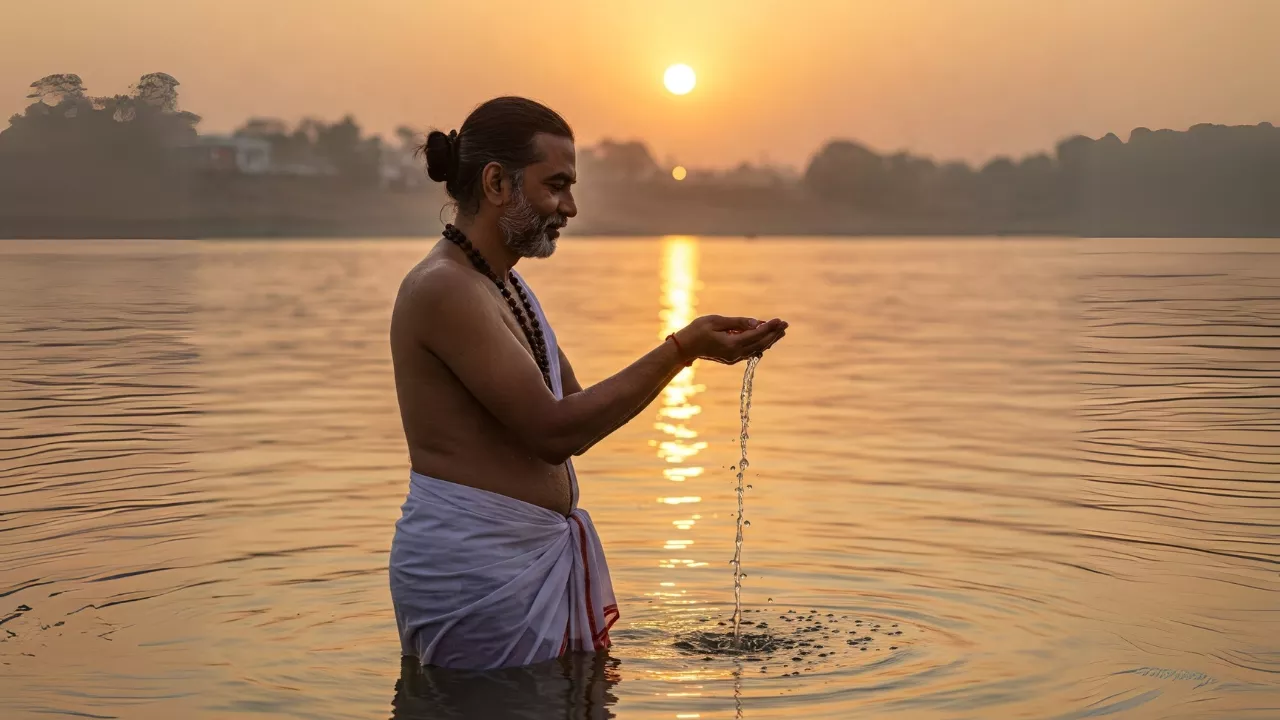Namaste,
The correct Tarpan hand posture mudra. How should we hold our hands when making the sacred offering (Tarpan) to our revered ancestors (Pitṛs)?
This is not merely about physical positioning; it is about aligning our actions with ancient wisdom, ensuring the flow of our offerings reaches its intended destination in the most efficacious way. Our Puranas, the deep wells of timeless knowledge, offer clear guidance.
Get the Flow Right: Mastering the Correct Tarpan Hand Posture (Mudra) for Ancestral Offerings
In the intricate tapestry of Hindu rituals, every gesture, every posture, holds meaning. These are not empty movements but physical expressions of inner intent, designed to channel energy and connect with specific divine or ancestral frequencies. The term Mudra (मुद्रा) itself signifies a ‘seal’ or ‘gesture,’ often used in worship (pūjā) and meditation (dhyāna) to evoke certain states or powers. While the elaborate finger-interlocking Mudras seen in deity worship might not be the primary focus in Pitru Tarpan, the specific way we position and use our hands is the crucial Tarpan hand posture mudra for this rite, and getting it right is vital.

Why Does Hand Posture Matter in Tarpan? The Subtle Energetics
Before we delve into the specifics, let us understand why such details are important. Tarpan is an act occurring at the intersection of the physical and subtle realms. We, in our physical bodies, are making offerings intended for beings existing in a subtler state – our Pitṛs. Our hands, through which the offering flows, act as conduits.
- Channeling Energy: Specific hand postures are believed to direct the flow of prāṇa (life force energy) and the essence of the offering in particular ways.
- Symbolic Significance: The posture conveys respect, humility, and the specific intention of the offering (e.g., distinguishing between offerings to Devas, Rishis, and Pitṛs).
- Scriptural Authority: Following the methods prescribed in the Puranas aligns our practice with sacred tradition, ensuring its validity and effectiveness according to ancient wisdom.
Therefore, adopting the correct hand posture is not mere formalism; it is about engaging with the subtle science embedded within our rituals to ensure our heartfelt offerings truly reach and satisfy our ancestors.
Puranic Guidance: Decoding the Correct Tarpan Hand Posture
Our primary guides in this matter are the Puranas, which detail the procedures for various rites. Let’s examine what they reveal about the hand posture for Pitru Tarpan.
The Foundation: Using Both Hands Joined Together (Brahma Purana)
A fundamental instruction comes from the Brahma Purana. It clearly states that when performing Tarpan, one “shall use both hands”. It doesn’t stop there; it elaborates on the process: after invoking the ancestor by name and Gotra (lineage) and uttering the sacred word “Tṛpyatām” (तृप्यताम् – “May they be satisfied”), the Purana specifies that “the left hand should be joined to the right hand (and thus the libation should be offered)”.
- Significance: Using both hands signifies a complete and wholehearted offering. It implies full engagement and respect, rather than a casual, one-handed gesture. The act of joining the left hand to the right creates a unified vessel, concentrating the intention and the flow of the offering. It represents humility and devotion in presenting the libation to the ancestors.
- Sanctity of Hands: The Brahma Purana also implicitly reinforces the unique role of the hands by cautioning against performing Tarpan with sesame seeds (til) placed on any other part of the body (“limbs other than the hands”). This underscores that the hands are the designated, sacred instruments for this rite.
The Sacred Channel: Pitṛ Tīrtha – The Ancestral Flow Point (Linga & Skanda Puranas)
This is perhaps the most crucial element of the Tarpan hand posture mudra specific to ancestors. While the Brahma Purana tells us to use joined hands, the Linga and Skanda Puranas specify how the water should flow from those hands when offering to Pitṛs.
- The Linga Purana Instruction: It states that Tarpan<span style=”font-weight: 400;”> offered to the Pitṛs should be performed with “waters flowing down the thumb of the right hand.
- The Skanda Purana Specification: This Purana provides even more precise terminology. When describing offerings to the Pitṛs, it directs that “the water should be let down on Pitṛ Tīrtha (the portion between the thumb and the forefinger)”.
Understanding Pitṛ Tīrtha (पितृ तीर्थ):
Tīrtha (तीर्थ) in this context refers to a sacred passage point on the hand. Our tradition identifies different Tīrthas for different beings:
* Deva Tīrtha: Fingertips (for offerings to Gods/Devas).
* Rishi Tīrtha: Base of the fingers/middle of palm (for offerings to Sages/Rishis).
* Pitṛ Tīrtha: The space at the base of the thumb, specifically the area between the thumb and the index finger of the right hand. This is the designated channel exclusively for offerings to ancestors.
- Why Pitṛ Tīrtha? Directing the flow through this specific point energetically attunes the offering to the frequency of the Pitṛ Loka (ancestral realm). Using the wrong Tīrtha (e.g., letting water flow from the fingertips as if offering to Devas) would be inappropriate and potentially ineffective for reaching the ancestors. Mastering the flow through the Pitṛ Tīrtha is central to the correct Tarpan hand posture mudra. It ensures the offering is directed correctly according to sacred anatomy and energetic principles.
Incorporating Kusha Grass (Darbha) in the Hand (Skanda Purana)
Sacred Kusha grass (Darbha) is another essential element, and its handling is part of the overall posture.
- The Skanda Purana Guidance: It advises that Tarpan for the Manes should involve “Darbhas mixed with gingelly seeds.” More explicitly relating to Shraddha (which includes Tarpan), it mentions, “libation with gingelly seeds should be offered while holding Darbha grass in one hand.”
- Practical Application: While the text doesn’t specify which hand holds the Darbha, common practice often involves holding a few blades of Darbha grass, usually with the tips pointing South (the direction of Pitṛs), perhaps tucked between the fingers of the left hand or held loosely within the joined hands, while the right hand primarily guides the water flow through the Pitṛ Tīrtha. The Darbha maintains purity, acts as a conduit for sacred energy, and provides a symbolic seat or connection point for the ancestors. The primary act of offering the libation remains focused on the right hand’s Pitṛ Tīrtha.
Integrating Timing and Intent (Brahma Purana)
The Brahma Purana links the physical act with the verbal invocation and mental intent. The offering is made after reciting the name, Gotra, and saying “Tṛpyatām“. This means the hand posture is assumed, the intention is focused, the invocation is made, and then the water is released through the Pitṛ Tīrtha with the feeling of satisfaction being offered. The posture becomes the culmination point where intention manifests into action.
Is This the Only “Mudra”? Distinguishing from Other Ritual Gestures

It’s important to clarify the terminology. While the Agni Purana, Garuda Purana, and Siva Purana indeed describe numerous intricate Mudras (like Avahani, Sthapani, Yoni Mudra, etc.) used in deity worship for specific purposes like invocation, installation, or offering various items, the Puranic guidance specifically for Pitru Tarpan focuses less on complex finger-interlocking Mudras and more on the correct orientation and flow from the hands via the Pitṛ Tīrtha.
Therefore, the essential Tarpan hand posture mudra for ancestors primarily involves:
- Using both hands joined together.
- Letting the water flow specifically through the Pitṛ Tīrtha (between thumb and forefinger of the right hand).
- Often incorporating Darbha grass held appropriately.
This specific configuration is the functional Mudra for this rite, ensuring the right energetic connection and flow.
Step-by-Step Visualization: Mastering the Flow of Tarpan
Let’s visualize the correct Tarpan hand posture mudra in action:
- Assume the Correct Body Posture: Sit facing South, perhaps kneeling on the left knee (as suggested in some texts) or sitting cross-legged on a clean asana (mat). Ensure your Yajnopavita (sacred thread, if worn) is in the Pracinavita position (over the right shoulder, under the left arm).
- Prepare the Offering: Hold Darbha grass appropriately (e.g., a few blades tucked in the left hand, tips pointing South).
- Take Water and Til: Cup your right hand slightly. Pour or take fresh water mixed with black sesame seeds (kala til) into your right palm.
- Join the Hands: Bring your left hand and gently join it to the right hand, supporting it or cupping it alongside. The hands now form a unified vessel.
- Invoke and Intend: Mentally (or softly aloud) invoke the specific ancestor by name and Gotra, followed by “Tṛpyatām“. Focus your loving intention and gratitude towards them.
- The Sacred Release (Pitṛ Tīrtha): Now, carefully and slowly tilt your joined hands forward and slightly downwards specifically allowing the water to flow out over the base of your right thumb, through the space between the thumb and the index finger (Pitṛ Tīrtha).
- Observe the Flow: Ensure the water does not flow from the fingertips (Deva Tīrtha) or other parts of the palm. The flow should be deliberate and controlled through the designated ancestral channel.
- Repeat: Repeat this process three times for each ancestor being offered Tarpan.
Mastering this flow takes a little practice, but it becomes natural quickly. The key is mindful awareness of where the water is exiting the hand.
The Deeper Meaning: Symbolism Embedded in the Gesture
This specific hand posture is rich with symbolism:
- Humility and Respect: Joining both hands is a universal sign of respect and offering.
- Focused Channel: The Pitṛ Tīrtha acts like a precisely aimed channel, ensuring the offering isn’t scattered aimlessly but directed with purpose.
- Completeness: The use of both hands signifies a total offering of oneself in the act of remembrance.
- Purity: The incorporation of Darbha maintains the sanctity of the offering and the performer.
- Connection to Lineage: The right hand, often associated with action and paternal lineage in some contexts, directing the flow via the Pitṛ Tīrtha reinforces the connection to the ancestors.
Common Mistakes to Avoid in Tarpan Hand Posture

Being mindful of the correct procedure helps avoid common errors:
- Wrong Tīrtha: Letting water flow from fingertips (Deva Tīrtha) – the most common mistake.
- One-Handed Offering: Casually offering with only one hand, without the supportive joining of the left hand.
- Incorrect Yajnopavita: Forgetting to place the sacred thread in the Pracinavita position (over right shoulder) negates the ritual context for Pitṛs.
- Rushing: Performing the action hastily without mindful focus and clear intention.
- Darbha Mishandling: Holding Darbha incorrectly or neglecting its importance.
Conclusion: Honouring Ancestors Through Mindful Gestures
The path laid out by our Puranas is meticulous because the journey involves subtle realms. Mastering the correct Tarpan hand posture mudra, as guided by the Brahma Purana, Linga Purana, and Skanda Purana, is a crucial step in performing this sacred duty effectively.
Remember the key elements: use both hands joined, let the sacred water mixed with black sesame seeds flow reverently through the Pitṛ Tīrtha (between the right thumb and forefinger), and incorporate Darbha grass with awareness. This posture is not merely physical; it is an energetic alignment, a respectful address, a focused channelling of your love and sustenance to those who came before you.
Perform this act with patience, devotion (bhakti), and mindfulness (Shradh). Let your hands become sacred vessels, carrying your gratitude across the veil. By getting the flow right, you ensure your ancestors receive the full benefit of your offerings, fostering their peace and drawing their invaluable blessings upon your entire lineage.
May your hands always move in accordance with Dharma, and may your ancestors be ever pleased and satisfied (tṛpta).
|| कल्याणमस्तु ||
